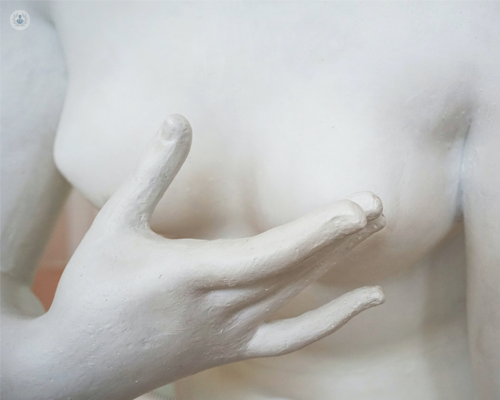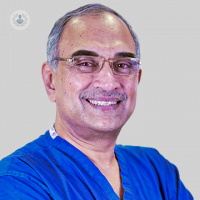Breast reconstruction after mastectomy: DIEP, TUG, and LAP flaps
Written by:If a patient is diagnosed with breast cancer, a mastectomy, surgery that removes all of the breast tissue including the cancerous cells, may be undertaken as treatment. Following a mastectomy, a patient may opt to have breast reconstruction, to restore the shape and look of the breast that was removed. In order to do this, tissue can be taken from other parts of the body to rebuild the breast. Where does this tissue come from? Esteemed Brentwood-based plastic surgeon Mr Venkat Ramakrishnan discusses the different parts of the body from where the reconstructive tissue is sourced, and compares these procedures.

What are DIEP, TUG, and LAP flaps? How are they utilised in breast reconstruction following a mastectomy?
DIEP, TUG, and LAP flaps are all technical names that refer to the areas from where the fat and skin tissue are taken to rebuild the breast after mastectomy.
DIEP flap stands for deep inferior epigastric perforators and comes from the tummy; TUG flap, or transverse upper gracilis flap, is from the upper thigh; and LAP (lumbar artery perforator) flap is from the lower back. These are the three areas where the tissue can be taken quite easily and without causing much damage to the area these tissues come from.
Which is the best reconstruction after having a mastectomy?
It is a very difficult to say which reconstruction is best, because the patients come in various, shapes, forms, and their needs are different. They might have had radiotherapy or chemotherapy; they might have excess tissue or they might not.
However, if all options are available, the best method for breast reconstructed is using the tummy tissue of the patient. It is very easy to get the tissue from the tummy and it has the added benefit of being one of the few donor sites, from where tissue is taken and the appearance of the donor site can be improved. The best form or what we would call it gold standard in breast reconstruction today is the deep flap that is from the tummy, DIEP flap.
What is the difference between the different type of flaps?
There are two common types of breast reconstruction; implant-based breast reconstruction and flap reconstruction.
Flap reconstruction involves the use of tissue from some part of the body. There are two main types of flap reconstruction, firstly there is using body tissue only, this includes DIEP flap, TUG flap and LAP, from places where there is excess tissue we can take and build the whole breast.
Secondly, there is another type of flap surgery where we use the flap with an implant. In people who do not have any tissue at all, we can use a back muscle flap, which is called a latissimus dorsi flap, and use it alongside an implant. This method was more common 20 years ago but it’s less favourable now, because it is worst of both worlds. it has to have an implant which requires maintenance surgery and it also has a flap which leaves a scar, so we most often use either implant only or flap only.
Is DIEP, TUG and LAP flap surgery painful?
Patients often ask me these questions and it's very easy for me to say it's not that painful but I haven't experienced the procedure. We tend to encourage patients to talk to other patients who have experience, but by and large the patients are quite surprised after they undergo the procedure, as it’s not as painful as they thought.
We are not cutting into nerves, bone or joints; it is only skin and fat. Immediately after the operation there might be some stinging or tenderness at the wound site, but apart from that the pain can be simply managed with paracetamol and ibuprofen.
What is the recovery time for DIEP, TUG and LAP flap reconstruction?
The recovery time for all three procedures is very similar. Generally, patients are told in six weeks they'll be back to everyday light activities like chores around the house, shopping, or driving. Returning to strenuous exercise, such as cardio or tummy crunches, can take eight to twelve weeks, depending on the patient.
Some motivated patients recover faster than others but normally in three months all patients will be back to doing everything they were doing before the procedure.
If you are interested in booking a consultation with Mr Venkat Ramakrishnan to get more information on breast reconstruction, you can do so via his Top Doctors profile.


